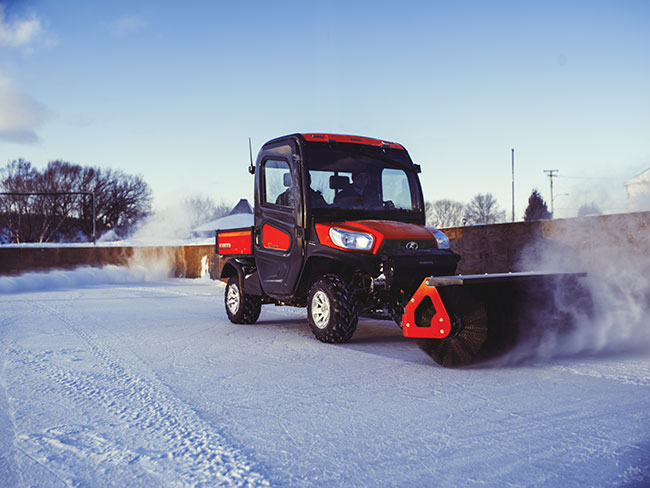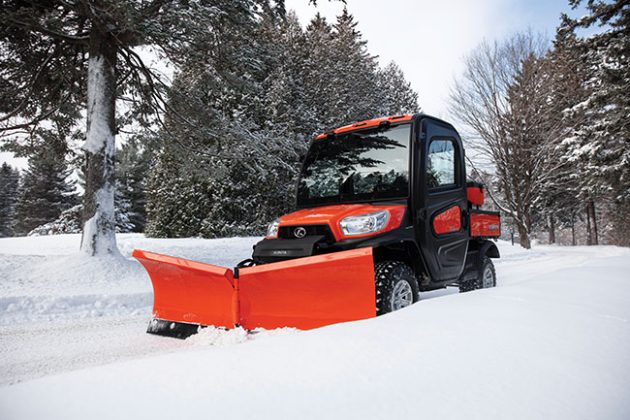
Features
Equipment
Fall/Winter Preparations
Golf & Landscaping
Landscaping
Municipal
It will soon be time to winterize equipment
Winterizing prevents internal engine corrosion and deteriorating equipment
June 27, 2022 By Chris Isaac
 Equipment needs to be winterized, whether it’s to keep working during the winter months or if it’s to be stored until the spring. Photo credit: Kubota
Equipment needs to be winterized, whether it’s to keep working during the winter months or if it’s to be stored until the spring. Photo credit: Kubota It won’t be long before the leaves start changing colour and the temperature starts to drop. With winter’s return just around the corner, knowing when and how to winterize your equipment will ensure that it keeps working as hard as you this winter.
Winterization is the process of preparing your equipment for winter conditions, either to continue working in the cold or to be stored until the weather warms up again and you get back to work. In general, winterization is one of the most important pieces of regular maintenance to do on your compact equipment, especially if you need it to perform in the cold and harsh conditions of a Canadian winter.
The main reason to winterize equipment is to prevent internal engine corrosion and deterioration, but it also provides a perfect opportunity to clean equipment and to identify and repair any damage and wear that have occurred over the summer.
When to start winterizing your equipment depends a lot on where in the country you are and what the forecast is. A good rule of thumb is to start winterizing your equipment when the frost starts to hit the ground.
Once the conditions indicate that it is time to start preparing for winter, the best way to start is to conduct the routine maintenance. Seasonal maintenance should be conducted regardless of temperatures to ensure the smooth running of equipment, but it is especially important as part of your winterization checklist. Checking and changing fluids and filters, and potentially even changing fluid types to one designed to perform in freezing temperatures is a must. Each climate is different so you should check the owner’s manual for your equipment on what fluids to use.
A good example of the importance of changing fluids comes in the fuel tank. In some colder regions, it’s necessary to change from the typical No. 2 Diesel (2-D) to No. 1 Diesel (1-D) for the snowy months. This change is done to prevent fuel gelling and ice crystals forming. However, in some cases a blend of 1-D and 2-D may be the most appropriate. If you aren’t sure what fuel or fuel blend your equipment needs, check the owner’s manual as it will have information on what your specific equipment needs.
When thinking about winter operation, coolant probably isn’t the first thing that comes to mind. However, even in the winter, it is important that the equipment’s cooling system is operating properly. Check to ensure you have proper coolant levels. Always use the manufacturer’s recommended mixture, testing the antifreeze to ensure it is the appropriate mixture.
Another fluid that needs to be checked is the oil. Cold, thick oil takes a toll on engines as they start up. When operating in the winter, thinner oil can make a big difference on the performance of your engine. A lower viscosity oil flows better within the engine when the temperature drops.

Winterizing also allows for identifying needed repairs to equipment.
Removing summer implements
The annual winterization maintenance is also the time to remove summer implements, such as mowers, and install the winter ones. Summer implements should be cleaned and have annual maintenance performed before putting it into winter storage. The winter implements can be attached and should be inspected and tested to ensure proper function before the first snowfall.
It’s also a good idea to test the battery as part of the winterization maintenance. As the weather gets cold, batteries lose their cranking power. This will be compounded if the battery is already old, with reduced performance. Additionally, parasitic draws will slowly drain the battery of energy when the equipment isn’t in use. If the equipment isn’t used regularly in cold temperatures, it is a good idea to use a battery maintainer.
If the equipment is stored outside for long periods of time, it is good practice to remove and story the battery indoors to extend its lifespan. If you need to test your battery, most agriculture and automotive dealers will test a battery for free, or a battery tester can be purchased. Checking the battery now will make sure the engine starts in the winter when you need it to.
Once the flurries fly, there are a few additional points to keep in mind. Whenever possible it is best to store equipment indoors, ideally somewhere heated. Keeping your equipment inside a building or shed will reduce the winter strain on it. If the equipment can’t be stored in a heated garage, make sure to leave enough time to allow the machinery to properly warm to above 40 degrees Celsius before starting work. The engine will function better when warm. Just like in your car, adding a block heater to your equipment will shorten the time needed to warm up the engine as well as help with cold starting performance.
While it can be time-consuming, setting aside the time to inspect your equipment on a daily basis can be critical for operating in the winter. It can be tempting, when the temperature drops, to just get to work so you can be done sooner and get out of the cold. No matter how cold, it is always worth it to take the extra time to complete daily cleaning and inspections. This will help you identify and fix small problems before they have the chance to turn into major ones.
It’s important to be particularly diligent in examining fluid hose lines regularly for cracks – cold wintery conditions put added stress on hoses, which often can crack in very cold temperatures. Also be sure to inspect oil and grease lubrication, coolant, fuel levels, battery function and the undercarriage, removing any excess snow, ice and salt that has built up. Cleaning the undercarriage and other areas of buildup is also essential if operating in salty conditions.
In addition to clearing off salt residue, the regular application of undercoating to the frame and metal components at the end of the workday will keep your equipment in top condition.
By catching problems when they are small, you can prevent major breakdowns and keep you and your equipment working not just for the current winter, but for the winters to come. From giving your equipment a thorough cleaning, washing away built-up dirt, grass and debris, to checking the engine fluids, filters and tire pressure, properly preparing your equipment for the arrival of winter conditions is one of the most important things you can do to ensure the long-term performance of your equipment.
Chris Isaac is an outdoor power equipment industry expert with Kubota Canada.
Print this page